Chevrolet Cobalt Service & Repair Manual: Component Service
Master Cylinder Overhaul
Impala
Disassemble
| Refer to Figs. 1
and 2, when performing the following procedures. |
| 1. |
Disconnect and plug hydraulic lines. |
| 2. |
Remove mounting nuts and master cylinder. |
| 3. |
Remove reservoir cover and diaphragm.
Discard old brake fluid. |
| 4. |
Inspect cover and diaphragm. |
| 5. |
Remove fluid level switch. |
| 6. |
On models equipped with compact
master cylinder,remove proportioning valve, Fig. 2. |
| 7. |
On all models, depress primary
piston and remove lock ring. |
| 8. |
Plug primary fluid outlet (outlet nearest
to cowl when master cylinder is installed), then remove primary
and secondary pistons by applying compressed air into secondary
fluid outlet. |
| 9. |
Remove secondary piston spring retainer
and seals. |
| 10. |
Remove secondary piston spring retainer
and seals. |
| 11. |
Clamp the flange on the master cylinder
body in a vise, then remove fluid reservoir, Figs. 3
and 4. |
| 12. |
Remove reservoir grommets. |
| 13. |
Inspect master cylinder bore for corrosion.
Do not use abrasive material on master cylinder bore. |
|
Assemble
| Clean all components not included
in repair kit with suitable brake fluid. Do not dry with compressed air.
Lubricate all rubber components with clean brake fluid prior to installation. |
| 1. |
Lubricate new reservoir grommets with
suitable silicone brake lube. |
| 2. |
Press grommets into master cylinder
body. Ensure grommets are properly seated. |
| 3. |
Lay reservoir upside down on flat,
hard surface. |
| 4. |
Press master cylinder body onto reservoir
using rocking motion. |
| 5. |
Install new seals on secondary piston
and spring retainer. |
| 6. |
Install spring and secondary piston
into cylinder. |
| 7. |
Install primary piston. |
| 8. |
Depress primary piston into cylinder
and install lock ring. |
| 9. |
Install fluid level switch, if equipped. |
| 10. |
On models equipped with compact
master cylinder,install proportioning valve, Fig.
2. |
| 11. |
On all models, install diaphragm
into reservoir cover and cover onto reservoir. |
| 12. |
Install master cylinder and bleed brake
system. |
|
Cobalt, DTS, G6, Lucerne, Malibu & SKY
| These master cylinders are not
serviceable. Master cylinder must be replaced as a complete unit. Do
not attempt to overhaul the master cylinder. |
Aveo & G3
| 1. |
Disconnect electrical connector from
reservoir. |
| 2. |
Disconnect brake lines from master
cylinder. |
| 3. |
Plug brake line openings to prevent
fluid loss and contamination. |
| 4. |
Remove power booster mounting nuts. |
| 5. |
Remove master cylinder assembly. |
| 6. |
Remove brake fluid reservoir. |
| 7. |
Remove seal ring from cylinder bore. |
| 8. |
Remove retaining ring from cylinder
body using suitable flat bladed tool. Discard ring. |
| 9. |
Remove primary piston. |
| 10. |
Carefully remove secondary piston assembly
and spring from master cylinder bore. |
| 11. |
Reverse procedure to install, noting
the following: |
| |
a. |
Clean all parts with clean brake fluid,
then dry with compressed air. |
| |
b. |
Replace all rubber parts and retaining
rings. |
| |
c. |
Lubricate master cylinder bore with
clean brake fluid. |
|
Corvette
| 1. |
Remove reservoir cap and diaphragm. |
| 2. |
Drain fluid into suitable container. |
| 3. |
Remove master cylinder prime pipe clamp
and prime pipe. |
| 4. |
Remove mounting screw and reservoir,
Fig. 5. |
| 5. |
Remove reservoir O-rings. |
| 6. |
Slightly depress piston and remove
retaining ring using suitable retaining ring pliers. |
| 7. |
Invert cylinder so reservoir wells
face downward. |
| 8. |
Depress primary and secondary pistons
until fully bottomed in bore using suitable brass rod or wooden
dowel. Secondary stop pin should fall freely from cylinder. |
| 9. |
Gently bump open end of cylinder body
against suitable wood piece to dislodge primary piston. Remove primary
piston. |
| 10. |
Gently bump open end of cylinder body
against suitable wood piece to dislodge secondary piston and center
valve. Remove secondary piston. Do not remove or disturb screw
which retains primary spring to secondary piston. |
| 11. |
Remove secondary return spring. |
| 12. |
Remove secondary piston spring retainer
using suitable small screwdriver to lift crimp and allow retainer
to slide off piston, Fig. 6. |
| 13. |
Remove secondary piston center valve
plunger and spring. |
| 14. |
Remove primary piston seal retainer
using suitable sharp knife or razor blade to cut and remove plastic
retaining cup retaining ring, Fig. 7. |
| 15. |
Remove recuperating guide. |
| 16. |
Remove pistons' rubber seals, Figs.
8 and 9. Do not damage any piston surfaces,
particularly areas where seals seat. |
| 17. |
Remove pressure differential switch.
Do not disassemble spring or probe. |
| 18. |
Remove end plug and O-ring. Do not
lose small electrical bias spring located just inside end plug. |
| 19. |
Remove warning switch. Keep warning
switch and probe together as an assembly. |
| 20. |
Remove end plug, O-ring and electrical
bias spring. |
| 21. |
Gently tap cylinder body against suitable
wood piece to dislodge proportioning valve spool. |
| 22. |
Remove proportioning valve spool including
O-ring and spacer. Do not disassemble proportioning valve. |
| 23. |
Proportioning valve is lubricated with
special grease. Do not use cleaning solution to clean it or components
included in repair kit. Clean other components in suitable denatured
alcohol. Dry components and passages within cylinder using filtered
compressed air. |
| 24. |
Reverse procedure to assemble. Ensure
seals and components are lubricated with clean brake fluid. |
|
CTS
| 1. |
Remove master cylinder as outlined
in Component Replacement. |
| 2. |
Place mounting flange into suitable
vise so piston is accessible. |
| 3. |
Ensure outside area of master cylinder
is clean of dirt and debris. |
| 4. |
Remove reservoir cap and diaphragm. |
| 5. |
Remove fluid level sensor and drain
master cylinder reservoir brake fluid into suitable container. |
| 6. |
Remove retaining pins and reservoir
from master cylinder. |
| 7. |
Remove seals from master cylinder reservoir. |
| 8. |
Remove piston retainer using suitable
tool. |
| 9. |
Remove piston from cylinder bore. |
| 10. |
Plug cylinder inlet ports and rear
outlet port, then apply low pressure compressed air into front outlet
port to remove secondary piston assembly. |
| 11. |
Reverse procedure to install. |
|
LaCrosse & STS
Disassemble
| 1. |
Remove master cylinder as outlined
in Component Replacement. |
| 2. |
Secure master cylinder mounting flange
in suitable bench vise so primary piston rear is accessible. |
| 3. |
Clean outside of master cylinder reservoir,
then remove reservoir cap and diaphragm. |
| 4. |
Replace cap and diaphragm if cut or
cracked, nicked or deformed. |
| 5. |
Secure master cylinder in suitable
vise. Do not clamp master cylinder body, secure only at flange. |
| 6. |
Remove brake fluid level sensor by
depressing tab with suitable nose pliers and pressing sensor through
reservoir. |
| 7. |
Tap out reservoir retaining pins. |
| 8. |
Remove reservoir and seals. |
| 9. |
Depress primary piston using smooth,
round-ended tool and remove piston retainer. |
| 10. |
Remove primary piston from cylinder
bore. |
| 11. |
Plug cylinder inlet and rear outlet
ports. |
| 12. |
Apply low pressure, non-lubricated,
filtered air into front outlet port and remove secondary piston
with primary and secondary seals, and return spring. |
| 13. |
Discard primary piston assembly, piston
retainer, seals and retainer from secondary piston. |
|
Assemble
| 1. |
Clean interior and exterior of master
cylinder, secondary piston and return spring in denatured alcohol,
or equivalent. |
| 2. |
Inspect the master cylinder bore, inlet
and outlet ports, secondary piston and return spring for cracks,
scoring, pitting, and/or corrosion. |
| 3. |
Dry master cylinder and components
with non-lubricated, filtered air. |
| 4. |
Lubricate master cylinder bore, secondary
piston, return spring and components with suitable brake fluid. |
| 5. |
Assemble lubricated, new primary seal,
retainer and new secondary seal onto secondary piston. |
| 6. |
Install lubricated return spring and
secondary piston assembly into cylinder bore. |
| 7. |
Install lubricated, new primary piston
assembly into cylinder bore. |
| 8. |
Depress primary piston using smooth,
round-ended tool, and install new piston retainer. |
| 9. |
Install lubricated reservoir seals.
Ensure they are fully seated. |
| 10. |
Install reservoir by pressing reservoir
straight down on master cylinder until pin holes are aligned. |
| 11. |
Tap reservoir retaining pins into place. |
| 12. |
Place brake fluid level sensor into
reservoir and press into place. |
| 13. |
Install reservoir cap and diaphragm. |
|
Vibe
| 1. |
Remove master cylinder from vehicle
as outlined in Component Replacement. |
| 2. |
Remove master cylinder bore O-ring
and two attaching rubber grommets. |
| 3. |
Secure master cylinder into suitable
vise, then remove piston stopper bolt and gasket. |
| 4. |
Remove snap ring pushing piston into
master cylinder. |
| 5. |
Remove plate, cylinder cup, O-ring,
piston guide and primary piston assembly from master cylinder. |
| 6. |
Remove secondary piston using suitable
hammer to tap cylinder flange against blocks. |
| 7. |
Inspect components for wear and damage,
replace as required. |
| 8. |
Reverse procedure to install. Bleed
brake system as outlined in Brake System Bleed. |
|
Wheel Cylinder Overhaul
Disassemble
| 1. |
Raise and support vehicle. |
| 2. |
Remove wheel, drum and brake shoes. |
| 3. |
Disconnect hydraulic line at wheel
cylinder. Do not pull metal line away from cylinder. Line
will separate from cylinder when cylinder is moved away from brake
backing plate. |
| 4. |
Remove mounting screws and wheel cylinder. |
| 5. |
Remove boots, pistons, springs and
cups, Fig. 10. |
|
Assemble
| 1. |
Clean components with suitable brake
fluid. |
| 2. |
Inspect cylinder bore. Scored bore
may be honed as long as diameter is not increased by more than .005
inch. |
| 3. |
Ensure hands are clean before proceeding. |
| 4. |
Lubricate cylinder wall and rubber
cups with suitable brake fluid. |
| 5. |
Install springs, cups, pistons and
boots. |
| 6. |
Wipe end of hydraulic line to remove
any foreign matter and place wheel cylinder in position. |
| 7. |
Enter tubing into cylinder and start
threads on fitting. |
| 8. |
Secure cylinder to backing plate and
complete tightening of tubing fitting. |
| 9. |
Install brake shoes, drum and wheel. |
| 10. |
Bleed brake system and adjust brakes. |
|
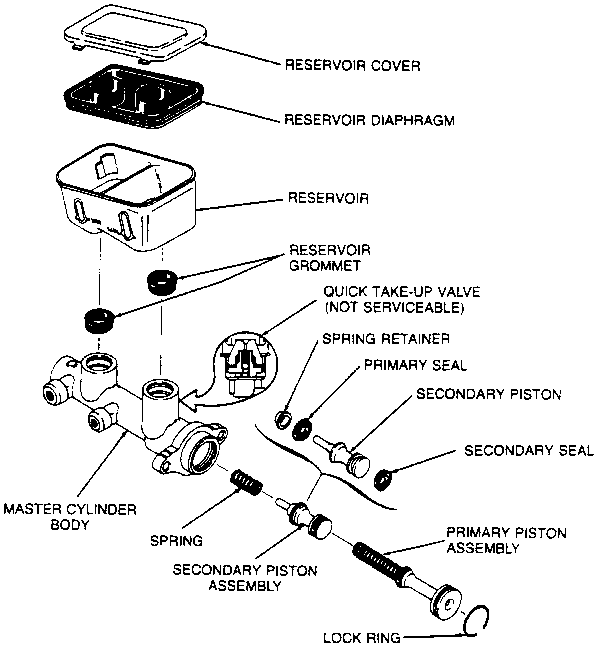
Fig. 1 Dual master cylinder assembly. Impala
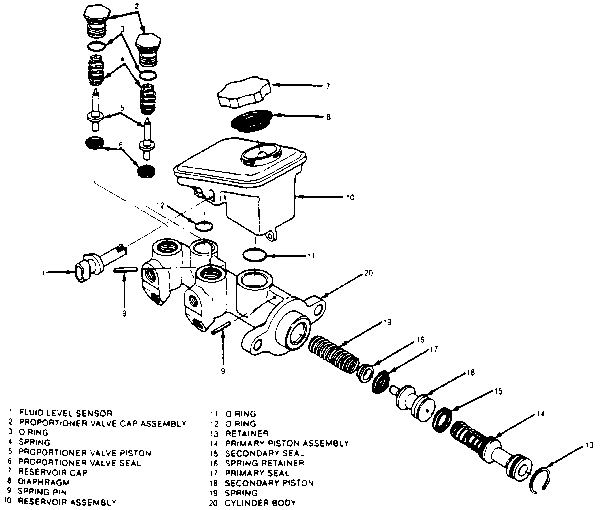
Fig. 2 Compact master cylinder assembly. Impala
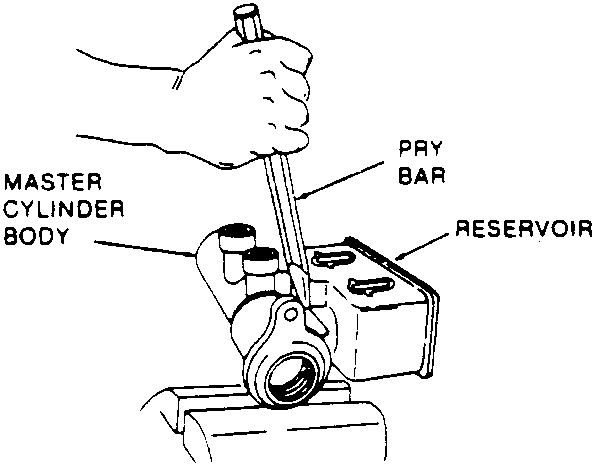
Fig. 3 Master cylinder reservoir replacement. Composite type less retaining pins
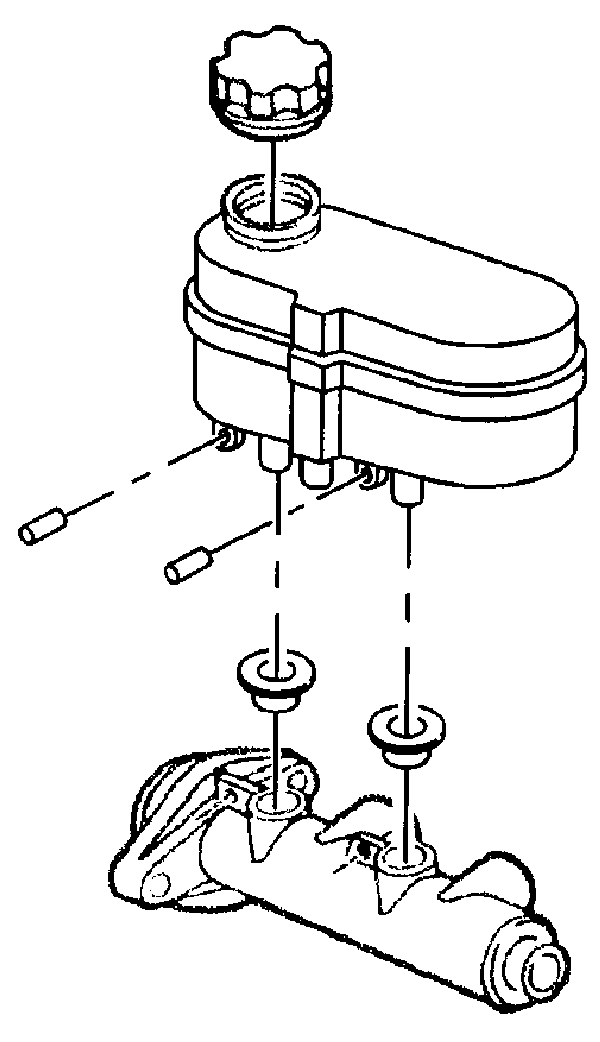
Fig. 4 Master cylinder reservoir replacement. Composite type w/retaining pins
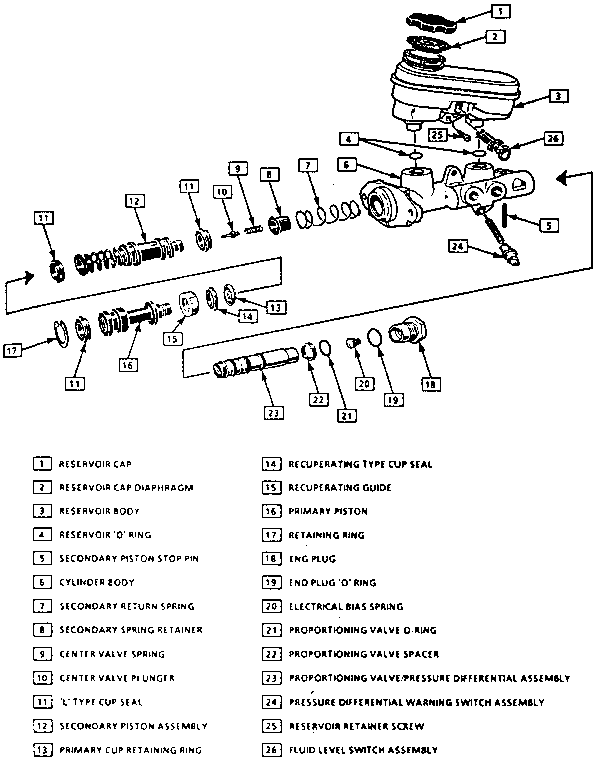
Fig. 5 Composite master cylinder replacement. Corvette
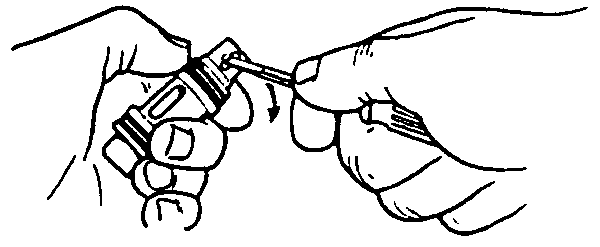
Fig. 6 Lifting crimp on secondary spring retainer replacement. Corvette
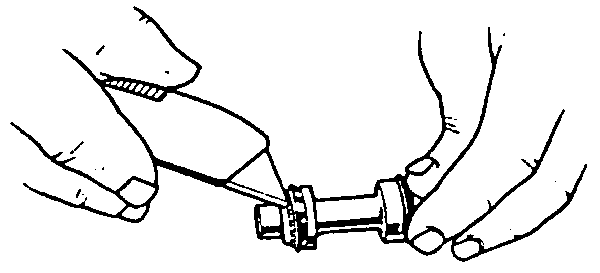
Fig. 7 Seal retainer cutting. Corvette
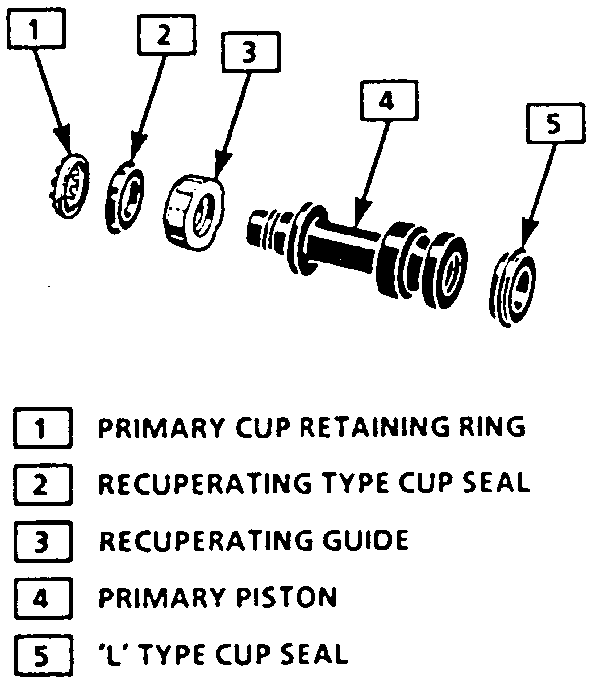
Fig. 8 Primary piston components. Corvette
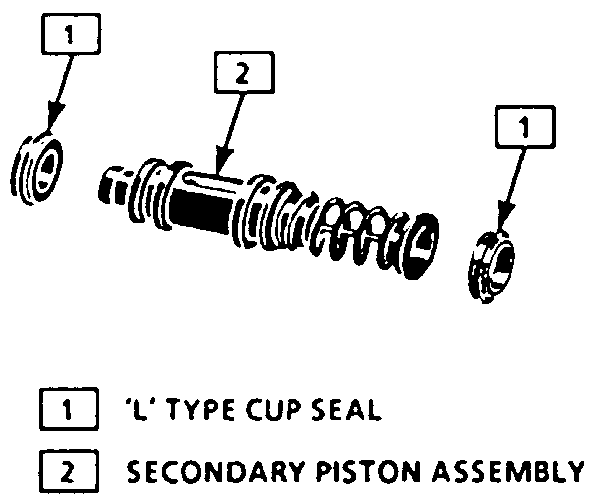
Fig. 9 Secondary piston components. Corvette
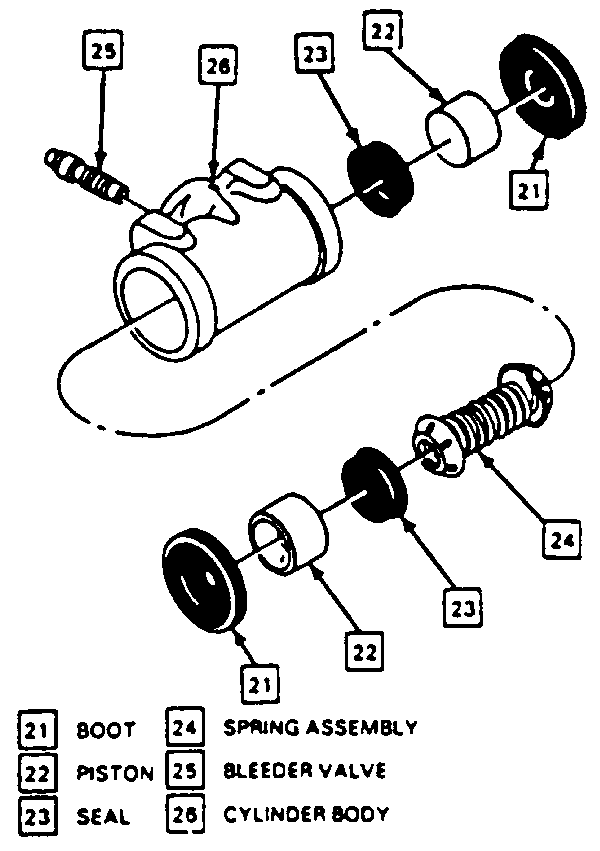
Fig. 10 Exploded view of wheel cylinder
Master Cylinder
1.
On Vibe models, remove air filter
hose clamp and hose from throttle body.
2.
On all models, disconnect fluid
le ...
Front & Rear Split System
When the brake pedal is depressed,
both the primary (front brake) and the secondary (rear brake) master cylinder
pistons are moved simultaneously to exert ...










 Component Replacement
Component Replacement Description
Description